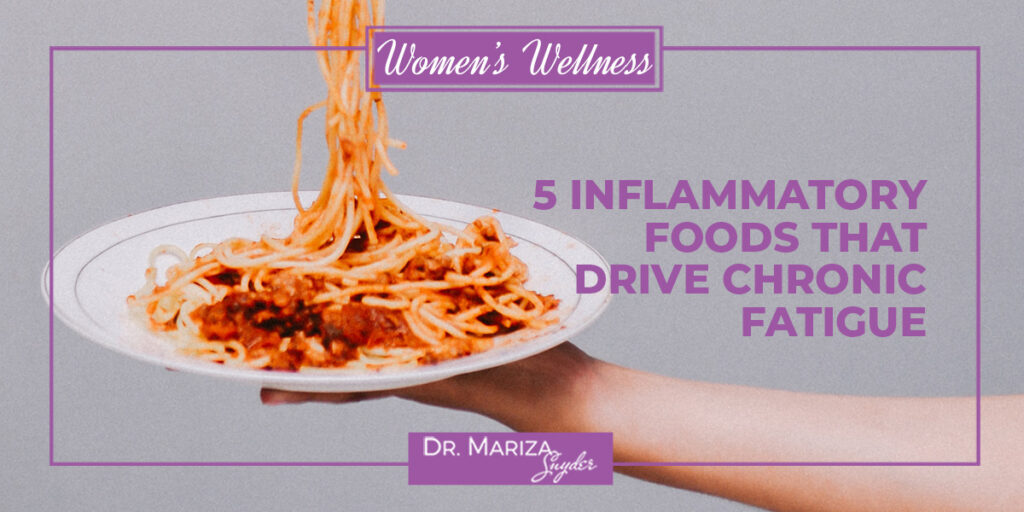
How crushing can chronic fatigue be– especially in the midst of perimenopause and menopause?
Not being able to do the things you love, not having the energy to play with your kids or grandkids, not being able to take care of yourself…
We’ve all felt the effects of fatigue before, but chronic fatigue is something we can avoid if we take charge of our diet.
About 10 years ago, I was experiencing chronic fatigue myself. I couldn’t even lift my head off the pillow in the morning.
I was so. exhausted.
I remember the hopeless feeling I felt. My mind endlessly racing while I was stuck in bed, unable to have enough energy to even get up and begin my day.
One of my first thoughts was “How am I going to take care of my patients if I can’t even take care of myself?”
It was then that I decided I needed to do everything in my power to avoid chronic fatigue. So I could feel like myself and continue to do the things I love.
And one of the first steps to avoiding chronic fatigue is eating the right foods.
Chronic fatigue is reversible- I’m proof that it can be done!
After minimizing and even eliminating the 5 inflammatory foods I’ll discuss in this blog, I’ve felt as energized as I’ve ever felt.
If you can relate to my story even a little bit, it’s time for you to look at your diet, and remove these 5 inflammatory foods to avoid chronic fatigue.
So you can feel enhanced energy levels and experience improved nutrient absorption.
But before we dive in, let’s look at what can cause chronic fatigue, and what the common symptoms of chronic fatigue are.
What’s Causing Your Chronic Fatigue?
Even if your fatigue isn’t as severe as mine was, you may have days where you feel just sort of… Meh.
Here’s some real talk– it’s totally normal for your energy levels to rise and fall slightly during the day.
Some natural reasons why your energy ebbs and flows include:
- How much sleep you’re getting
- Where your stress levels are
- How much physical activity you’re getting
- What kinds of meals you’re eating
If your meals aren’t perking you up– even a little bit– it’s time to take a look at what’s stealing all your energy.
Generally speaking, a good meal should refuel your tank.
It should give you some kind of energy boost.
And I’m not referring to a sugar high after a mid-day cupcake. I’m talking about the feeling of real satisfaction and motivation you should get from a good snack or meal.
Food can cause chronic fatigue for several reasons.
Foods you’re eating could be:
- Too high in sugar (this list is endless!)
- Too high in carbohydrates, especially processed starchy carbs.
- Prepared with too much fat, particularly unhealthy oils like canola or vegetable oil (think fast food!)
- Too low in calories.
- Too low in nutrients.
- Missing key proteins, enzymes, fats, and fibers that make it easier to digest (and preserve your energy!)
When considering these factors, you can start to see that certain foods put you on the blood sugar roller coaster, OR they’re not getting the job done because they lack nutrition or are over-processed.
Common Signs of Chronic Fatigue
When I experienced chronic fatigue, I couldn’t even get my legs off the bed in the morning. I was so wiped out that I could barely have the strength to lift my head from the pillow.
Now, this is a more extreme case. Chronic fatigue can present in other, less debilitating ways.
Other common signs and symptoms of chronic fatigue include:
- Problems with memory
- Dizziness
- Headache and light sensitivity
- Muscle and joint pain
- Inability to concentrate
If you’re experiencing any of these symptoms, taking the steps to change your diet can be one of the best things you can do.
Once you learn to eliminate the top 5 inflammatory foods causing chronic fatigue, you’ll be on your way to feeling more like your energized self.
The 5 Worst Foods Driving Chronic Fatigue
Now that you have an understanding of why certain foods can make you tired, let’s get into the top 5 worst foods that are draining your energy and leading to chronic fatigue.
#1 – Processed Grains: White Bread, Pasta, and Packaged White Rice
Grains are rich in carbs, which gives your body a good source of energy.
But processed grains like those found in white bread, white pasta, and white rice may cause more harm than good when it comes to your energy levels.
The fiber-containing outer layer of the grain– known as the bran– is removed during processing. Because of this, processed grains contain lower levels of fiber.
They tend to be digested and absorbed more quickly than whole grains.
So a meal or snack rich in processed grains generally creates a quick rise in blood sugar and insulin levels, followed by a steep drop in energy.
Processed grains also lack another important part of the grain– the germ.
The germ contains many important nutrients– like B vitamins– that can also play a role in maintaining your energy levels.
So a huge step you can take to avoid chronic fatigue is minimizing these processed grains.
Eat this instead:
- Opt for whole grains next time you’re craving more carbs in your meals.
- Try whole-grain bread, oatmeal, or brown rice.
#2 – ANYTHING with Added Sugar!
When you’re starting your day, you want to make sure you don’t have added sugars in your breakfast.
Even foods like breakfast cereal and flavored yogurt have added sugars that can lead to chronic fatigue.
Tons of foods on the market are packed with added sugars. And when consumed too frequently, they can take a toll on your energy levels.
For instance, many people consider breakfast cereals an important part of a healthy and energizing breakfast routine.
However, most packaged cereal is hijacking your energy.
That’s because they have very little fiber yet significant amounts of added sugars.
Did you know sugars make up as much as 50% of the total carbs found in many popular breakfast cereals?
The combination of high sugar and low fiber content can spike blood sugar and insulin levels, leading to a rise in energy, followed by a sudden crash.
Some research also suggests eating foods high in added sugars may increase the likelihood you’ll crave other sugary foods, potentially creating an energy-depleting cycle.
Other popular breakfast foods that tend to contain high levels of added sugars include:
- Flavored yogurts
- Juices
- Muffins
- Granola bars
- even some types of bread
And don’t kid yourself… added sugars are in tons of foods outside of breakfast foods as well!
Make sure you double-check your labels when you’re buying any meal or snack items to make sure they aren’t packed with added sugars.
Eat this instead:
- Next time you want something sweet for breakfast, have a homemade smoothie withs LOTS of greens and fiber.
- Or try overnight oats sweetened with a dash of maple syrup.
- Snack on whole fruits or veggies instead of packaged snacks.
#3 – Sugary Beverages- Including the Sneaky Ones!
From your morning Frappuccino to your afternoon “Super” Juice– even drinks like these that you may not consider unhealthy can have loads of added sugars.
Much for the same reason as breakfast cereal, the hidden added sugars in your Starbucks coffee, flavored water drinks, or even some “health” juices are doing you way more harm.
What may feel like a burst of energy is your body going down the first giant drop of the blood sugar roller coaster.
And before you know it, you’re back at the starting gate wondering why the ride was so short– and how quickly you can get on another one.
Sugary drinks like these throw your blood sugars completely off balance, leading to crashes and ultimately causing chronic fatigue.
Drink This Instead:
- It may sound boring, but opt for plain tea or coffee in the morning
- You can always sweeten it with a little honey if you need it!
- If you want some fresh pressed juice, make sure it’s actually fresh– or better yet, make it yourself!
- Hydrate with water! Add lemon or cucumber to give it some flavor and help detoxify the body.
#4 – Highly Processed Foods
You know the kind. Common highly processed foods that lead to chronic fatigue include frozen pizzas or meals, packaged cookies, and fast food.
Not only are these foods typically loaded with sugar, but they’re also completely empty of nutrients.
Get in the habit of reading the ingredients if you’re not sure!
You’ve probably heard the term empty calories. This is the very definition of it– calories from foods with no nutritional value.
The problem is, you can guarantee you’ll be spiking your blood sugar when you eat processed foods like these.
You’re also flooding your bloodstream with a host of other super unhealthy ingredients like low-quality fats and trans fats, natural flavors, chemicals, and other toxins that are known to zap your short and long-term energy levels.
So next time you’re looking to snack, think to yourself: “Is this really giving me any nutritional value?”
If not, toss it and grab something healthier!
Eat this instead:
- When in doubt, make your own meals!
- Skip the fast food, and create easy, metabolically balanced meals.
- You also can find some great dessert recipes that use natural ingredients and sweeteners to satisfy your cookie craving!
#5 – Alcohol– ALL of It
Just like all sugar is created equally, alcohol is no different.
Alcohol is sugar.
Not only does it spike your blood sugar and send you roaring down the blood sugar roller coaster, but it’s also:
- Intoxicating
- Super hard on the liver
- And a major pro–inflammatory.
That hangover you experience after drinking isn’t an accident. It’s your body’s way of doing everything it can to save itself from last night’s binge.
Naturally, alcohol will zap your energy levels– and it can take days to recover.
The older we get, the longer the recovery takes.
So on days before you have something important to do…(which is probably every day!) Ask yourself: “Do I want a spinach and salmon brain or a pizza, ice cream, and margarita brain?”
Your answer in this case should be an easy one.
I get it, there’s a time and a place to indulge in alcohol…
But the more you do, the more your energy pays for it later!
Drink this instead:
- I’ve been loving my mocktails lately– make a craft drink without booze!
- Squeeze some fresh citrus into a glass of soda water, and add a dash of fresh mint!
The Bottom Line
Highly inflammatory foods throw our blood sugar levels out of whack, leading to sugar rushes and crashes. Over time, this decreases our energy levels and leads to chronic fatigue.
The top 5 foods to avoid that are driving chronic fatigue include:
- Processed grains
- Anything with added sugars
- Sugary drinks
- Highly processed foods & fast food
- Alcohol
Prioritizing a whole food diet with whole grains, fruits, and vegetables is the best way to avoid chronic fatigue and feel energized day to day.
I have a FREE guide on healthy anti-inflammatory foods that can help you get started with eliminating these 5 foods from your diet. So download it now!
Just remember, it’s not hard to create healthy, metabolically friendly meals -without ANY of these inflammatory foods. Check out my podcast on metabolically balanced meals, and start your journey towards a more energized life.
Want to take your diet and lifestyle one step further for the ultimate hormone and metabolic makeover?
If you’re looking for a blueprint to enhance your energy levels and improve your metabolic functioning, check out my..


No comments yet.